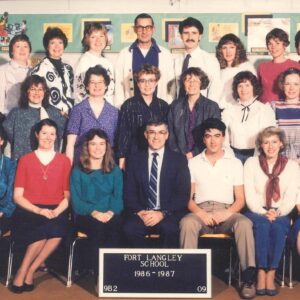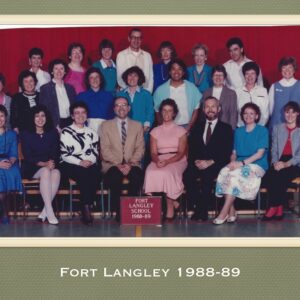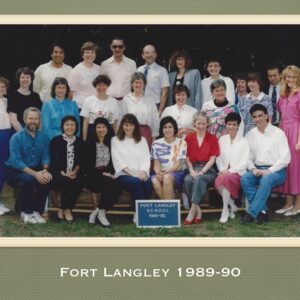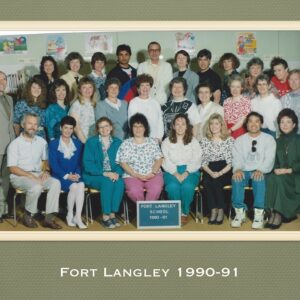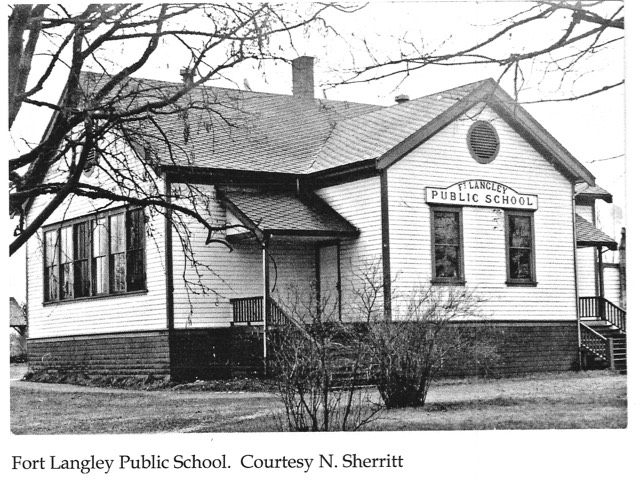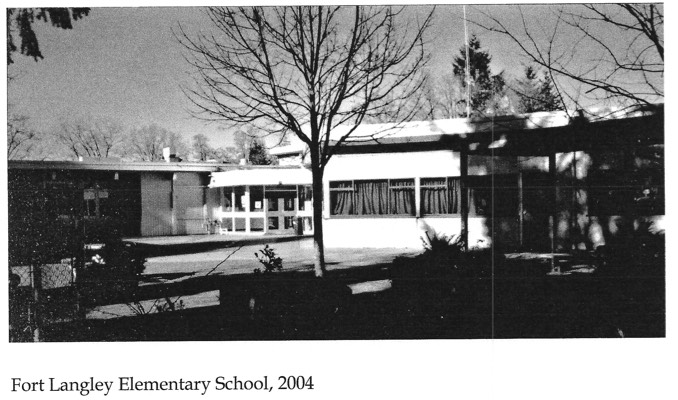Since 1867, there have been six Fort Langley Elementary Schools located from Derby to the present site on Bartlett Street.
Derby (west of present Fort Langley) was proclaimed the site of the capital of BC in November, 1858, but the capital was moved to New Westminster in 1860. Despite declining population and the disappearance of some buildings, there were enough settlers in the Derby area to require a school. On December 1,1866, the residents petitioned Governor Seymour to establish a school in Derby. Five men were appointed as trustees (William J. Howison, Q. Wickwire, Kenneth Morrison, Samuel Robertson, and Peter Baker), and the government set aside one of the abandoned government buildings for the school. They granted $1 a month for each child plus an additional grant of $250 for the balance of 1867. The temporary appointment of a teacher was left in the hands of the trustees. James Kennedy, who had spearheaded the petition, was appointed as the first teacher of the school which was opened on April 27,1867. The school house, with a residence for the teacher, stood on one-half of an acre of land given by the Hudson’s Bay Company. The inspector noted that it was much in want of maps and school apparatus. The enrolment was 17. The school closed in 1868, and Mr. Kennedy moved to the new school where he taught another four years before being asked for his resignation.
A new school was built at Fort Langley and opened on November 23,1868. It was located on Hudson’s Bay property on Mavis Street, not far from the old Fort. John Maxwell’s brother-in-law, Simon Carmen, built a house and barn on the Maxwell farm, using lumber from the first school house at Derby. This second school was destroyed by fire in the early 1870s.
A new site was chosen at the northeast corner of Hudson Bay Avenue and Glover Road, and on August 8,1872, the new school opened under the auspices of Mr. W. W. Gibbs. It is interesting to note that the first council meeting, when Langley was incorporated as a municipality, was held in this little red school house in 1873. An old negro ex-slave known only as “Alex, the Darkie,” when he heard where the school was to be situated, made a remark which was often laughingly recounted by the old timers: “Why the dickens didn’t they build it on the river bank where the kids could see the steam boats instead of way back in the bushes with the rabbits?” he asked. Some children travelled several miles to this school on foot or on horseback.
In 1874-5 the Public Schools Report was not very complimentary of the school, “…the children were backward…(with) highly irregular attendance, little interest from parents, teachers not enthusiastic…” Fortunately, things changed in 1876 when Mrs. Frances E. Herring, a fully qualified teacher, arrived. The report in 1878 was improved.
Mr. Wright, Mr. R. Holding, Mr. W. H. Brown, Mr. W. T. Plaxton, and Mr. A. H. P. Matthews were pioneer teachers at this early school. Mr. Matthew’s own children were enrolled with about 25 others in Grades 1 to 8.
In 1898 a new school was built beside the old one, and the old one was moved across the street to be converted into a dwelling. The pupils were startled during school hours when they heard a great crashing noise. The bricks of the chimney were falling as the school was moved from its foundation.
At this time the children carried water in a bucket from the Simpson farm, and all drank from the same tin dipper. In 1900 fir trees were planted around the school, some of which still stand.
In 1911 a new two-room school was built on the present school grounds. Mr. Plaxton, the teacher, moved his pupils from the corner to the new school. The old school was torn down and the lumber used to build a house on Wilson Townline Road. A third room was added in 1923, and in 1951 a one-room unit was brought in to accommodate grades 1 and 2.
Some of the teachers who taught at Fort Langley in these early years include Mr. Garfield A. King (lawyer in Vancouver), Miss Mary Pack (Arthritis Society), Mrs. Keith Nettleton, Mrs. Jenny Medd, Mrs. B. Finlayson, Mrs. A. Greenwood, Mrs. Coates, Mrs. Mair, Mrs. O’Brien, and Mrs. Cook. Mr. Norm Sherritt started his career in 1940 at this school.
The present school at 8877 Bartlett Street has had many renovations over the years, including a new roof in the 1980s. It has two intermediate playing fields, a galvanized chain link fence, two swings, three climbers, four bars, 1 giant slide, a dome climber, and an asphalt play court. It is on sewer and water and has mainly hot water heating. The original building was of block construction in a 5-sided shape. Later additions were wood frame. In 2004, there are 278 pupils attending Fort Langley Elementary.

